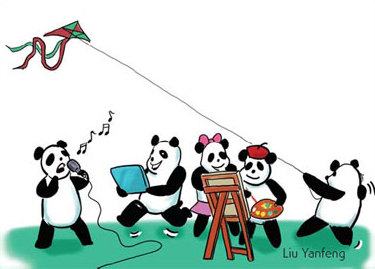Look! It's the brand new face of China
By Tim Adams (China Daily)
Updated: 2008-03-11 07:22
Updated: 2008-03-11 07:22
Twenty years ago, China did not have a word for "designer". There were "artist workers" who fashioned utilitarian packaging, and makers of all kinds of posters, but design as an idea in itself was un-Chinese, bourgeois.
After Deng Xiaoping said people should be rich, and China began to open its markets to the world in 1992, there was, therefore, a great deal of catching up to be done.
The exponential trajectory of this catching up is the subject of China Design Now at the V&A, London.
The project was conceived four years ago, but since four years in the current Chinese economy is the equivalent of four decades anywhere else, its challenge has been to try to capture exactly the "now" of the current Chinese moment. It does so with stylish clarity.
The exhibition is organized around the three cities that have shaped China's emergence into the world.
Shenzhen, the "economic zone" that opened China up to the world, with its day-tripping shoppers and pioneering businessmen from Hong Kong; Shanghai, the perennial style center of the country, one of the fastest growing cities on earth; and Beijing, the capital, which has re-imagined itself through a vast building program.
Like all stories of towering ambition this one has quite humble foundations. In the late 1980s two young colleagues working at the Guangdong Provincial Packaging Company, sensing that China needed a new graphic language to explain itself to the world, set up the nation's first design consultancy in Shenzhen.

Wang Xu and Wang Yuefei gathered other designers around them and set about thinking of China as a brand. Their early efforts tended to play with calligraphy and traditional Chinese symbolism looking for the new spirit in old characters.
In recent years this studious graphic language has given way to a more home-made visual vernacular which is captured in the fliers and packaging of the new urban youth culture, with its hip-hop caricatures and slightly naive appropriation of European pop trends.
These younger designers, influenced by Japanese manga cartoons, universal graffiti styles and Britpop, are in search of that most intangible of all Western inventions, "ku" ("cool").
They are led by the so-called "1980s generation" of artists and writers, such as the iconoclast novelist Han Han, and are the stuff of fantasy for the marketing departments of global corporations.
There are Nike trainers that play with Chinese style - limited editions for the Year of the Dog and so on - and skateboards decorated with ironic slogans of the 1950s to 1960s.
What is clear from this display is that the emergence of design in China is inseparable from the emergence of the self-conscious, brand-aware individual. Nowhere is this felt more keenly than in Shanghai.
The mass migration of Chinese to cities - more than 100 million people in the last decade - and the rise of a wealthy elite and a growing middle class finds its most dramatic expression in the nation's consumer capital.
In the 1960s, Chinese aspiration stretched not much further than ownership of "the four great things" - a bike, a radio, a sewing machine and a watch.
These days, the four great things are a house, a car - preferably a BMW - a mobile phone and a computer. In a recent survey two thirds of young Shanghainese were said to be active bloggers.
China is importing three pillars of Western-style consumerism: fashion, celebrity and the world of interiors.
Chinese homes, recreated in photograph and model, ape the international style, stainless steel kitchens and claw-footed bathrooms, but always with a parochial twist, a discreet lantern or a nod to the opulent boudoir style of 1920s Shanghai.
Fashion trends have been set in motion by iconic Chinese films such as Wong Kar-wai's In the Mood for Love. Chinese celebrities, led by Zhang Ziyi, the star of Crouching Tiger, Hidden Dragon and the Chinese face of Garnier and Maybelline, occupy the current public spaces. "Super Girl" in fact was the Chinese version of "Pop Idol".
Beijing's three architectural projects - expertly visualized - all originated in Europe.
Rem Koolhaas, the Dutch maverick, has created a new China TV building which does not so much defy gravity as make Newton look a nonsense; Norman Foster's dragon-inspired airport, which opened last month, features a terminal building about three km long; and Swiss-based Herzog and de Meuron's Olympic stadium is an inspired and witty bird's nest of steel.
I wandered round these three vast buildings, in various states of readiness, last summer, and was struck by the unavoidable contingencies of China's rapid growth.
It took 50,000 men to construct the airport, and armies of them were at work with ancient shovels and wheelbarrows when I visited - it was like watching the pyramids being built. It looked too like a metaphor: countless men stuck in the old China, toiling resolutely to complete the shiny design of the new.
The Observer
(China Daily 03/11/2008 page10)
|
|
|
|
|
|